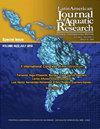neei在水培中降低盐度:对海洋养殖废水修复的影响
IF 0.8
4区 农林科学
Q3 FISHERIES
Latin American Journal of Aquatic Research
Pub Date : 2023-07-02
DOI:10.3856/vol51-issue3-fulltext-3031
引用次数: 0
摘要
盐碱化已成为影响全球生态平衡的主要环境问题之一。海水养殖等含盐工业废水的排放及其在过去几十年中在全球产量的快速增长已成为这一问题的重要组成部分。盐生植物Sarcocornia neei(Lag.)已证明其具有从含盐废水中去除和吸收营养物质的能力,使其成为植物修复系统中应用的一个有前途的候选者。在这项研究中,对其降低水盐度的能力进行了评估。为此,将植物在四种不同盐度(A)0、B)10、C)20和D)30 g L-1的人工流出物中饲养53天。在添加NaCl的所有处理中都获得了显著的盐减少。治疗C的降幅最大,减少了6.91±1.52 g L-1,约占试验开始时添加总量的35%。植物耐受所有含盐范围;在任何治疗中均未观察到死亡或盐应激症状。研究结果首次表明,印楝可用于含盐废水的生物脱盐。需要进一步的研究来评估其在集成到含盐工业废水中的中试系统中的应用。本文章由计算机程序翻译,如有差异,请以英文原文为准。
Salinity reduction by Sarcocornia neei in hydroponics: implications in marine aquaculture wastewater remediation
Salinization has become one of the main environmental problems affecting the worldwide ecological balance. The effluent discharge of saline industrial effluents, such as marine aquaculture, and its rapid increase in global production in the last decades has become an important part of this problem. The halophyte Sarcocornia neei (Lag.) has proven its ability to remove and assimilate nutrients from saline wastewater, making it a promising candidate for application in phytoremediation systems. In this study, its ability to reduce water salinity was evaluated. For this purpose, the plants were reared for 53 days in artificial effluents at four different salinities: A) 0, B) 10, C) 20, and D) 30 g L-1. A significant salt reduction was obtained in all treatments with NaCl addition. The maximum decrease was achieved in treatment C, reducing 6.91 ± 1.52 g L-1, approximately 35% of the total added at the beginning of the trials. Plants tolerated all salt content ranges; no mortality or salt stress symptoms were observed in any treatment. The results obtained are a first approach suggesting that S. neei could be used for bio-desalination of saline wastewater. Further studies are needed to evaluate its application in pilot systems integrated into saline industrial effluents.
求助全文
通过发布文献求助,成功后即可免费获取论文全文。
去求助
来源期刊

Latin American Journal of Aquatic Research
FISHERIES-MARINE & FRESHWATER BIOLOGY
CiteScore
1.70
自引率
10.00%
发文量
44
审稿时长
4-8 weeks
期刊介绍:
Latin American Journal of Aquatic Research- LAJAR is the continuation of the journal Investigaciones Marinas (1970-2007) and is published since 2008 by the Escuela de Ciencias del Mar, Facultad de Ciencias del Mar y Geografía of the Pontificia Universidad Católica de Valparaíso. LAJAR is an “Open Access” journal that publishes in English language, original research articles, reviews and short communications on aquatic science, which contain the results of research conducted in aquaculture or in oceanic and coastal marine waters of Latin America.
The following topics are considered: Physical Oceanography, Chemical Oceanography, Marine Biogeochemistry, Marine Pollution and Toxicology, Marine Geology and Geophysics, Biological Oceanography, Fisheries and Aquaculture.
 求助内容:
求助内容: 应助结果提醒方式:
应助结果提醒方式:


